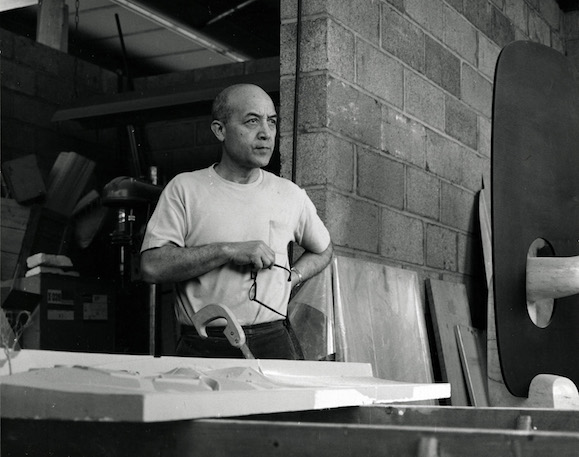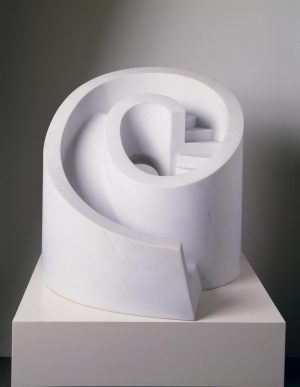Beyond the Pedestal: Isamu Noguchi and the Borders of Sculpture

By Carl Little
You might call it Isamu Noguchi unplugged. The 40 or so sculptures and ten works on paper in this somewhat patchwork loan show from The Isamu Noguchi Foundation and Garden Museum in New York highlight the Japanese-American sculptor’s forays into places “beyond the pedestal”—playgrounds, the stage, interiors—while sticking to his artistic mission: “to order and animate space.”
Noguchi (1904-1988) worked on several playground projects, bringing a modernist aesthetic to them. The maquette for Slide Mantra (ca. 1985), made from Botticino marble, could stand alone as a geometric abstract sculpture, yet a blown-up photo of the artist taking a turn on the realized version demonstrates its function. Six graphite studies for playground equipment in Ala Moana Park on Oahu in Hawaii offer a glimpse of his design process.

Opening Image: Isamu Noguchi working on model for Riverside Park Playground, 1963. ©The Isamu Noguchi Foundation and Garden Museum, New York / ARS. Photo by Michio Noguchi.
Above: Isamu Noguchi, Slide Mantra, ca. 1985, Botticino marble, 27 1/4 x 24 1/4 x 27 3/4″. Courtesy of the Portland Museum of Art.
On many occasions Noguchi designed props and sets for choreographers, including Martha Graham, Merce Cunningham and Erick Hawkins. The exhibition includes his 13-foot-high Jungle Gym (1947), a brightly colored stripped-down Calder-esque construction used in Hawkins’s Stephen Acrobat. A photo shows a dancer swinging on it during a performance.
Over the years Noguchi designed household furnishings, often in partnership with design companies. Several items are on view here, including a couch and Ottoman set, hanging lanterns, and a “rocking stool.” Radio Nurse (1937), a prototype for a baby monitor, was fabricated from Bakelite for the Zenith Radio Corporation. The head-shaped device with its mask-like grill comes off as a spooky collectible.

Above: Isamu Noguchi, Jungle Gym, 1947, steel, plastic and paint. Courtesy of the Portland Museum of Art.
Noguchi also explored abstract concepts. In the somewhat comically titled Costume for a Stone (1982), a jagged piece of granite thrusts through a collar-like frame of hot-dipped galvanized steel. For Beginnings (1985), he arranged five large volcanic andesite rocks in a Zen garden-like configuration. The rocks appear to emerge from the floor like atolls.
In his lifetime, Noguchi witnessed some of the worst of humanity, including the internment of Japanese-Americans during World War II. He voluntarily spent six months in the Poston War Relocation Center in the Arizona desert, hoping to better the conditions for the detainees. Yellow Landscape and My Arizona, both 1943, conjure the lunar-like terrain of the camp in highly abstract formats. Noguchi was a modernist even when it came to reflecting on a dark period in American history and his own life.
Beyond the Pedestal: Isamu Noguchi and the Borders of Sculpture is on view at the Portland Museum of Art through January 6, 2019.
